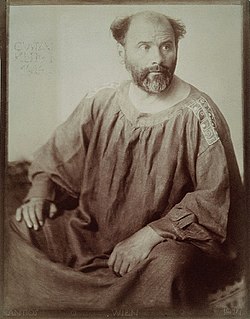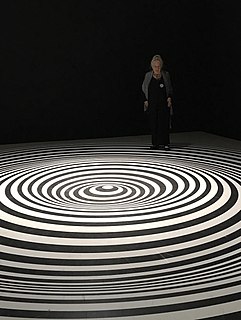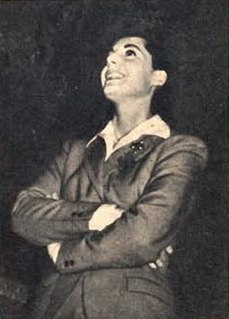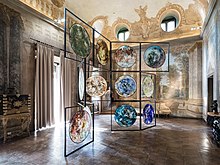
Gustav Klimt was an Austrian symbolist painter and one of the most prominent members of the Vienna Secession movement. Klimt is noted for his paintings, murals, sketches, and other objets d'art. Klimt's primary subject was the female body, and his works are marked by a frank eroticism. Amongst his figurative works, which include allegories and portraits, he painted landscapes. Among the artists of the Vienna Secession, Klimt was the most influenced by Japanese art and its methods.

Liberty style was the Italian variant of Art Nouveau, which flourished between about 1890 and 1914. It was also sometimes known as stile floreale, arte nuova, or stile moderno. It took its name from Arthur Lasenby Liberty and the store he founded in 1874 in London, Liberty Department Store, which specialized in importing ornaments, textiles and art objects from Japan and the Far East. Major Italian designers using the style included Carlo Bugatti, Raimondo D'Aronco, Eugenio Quarti, and Galileo Chini. The major event of the style was the 1902 Turin International Exposition, which featured by works of both Italian designers and other Art Nouveau designers from around Europe.

Franco Fontana is an Italian photographer. He is best known for his abstract colour landscapes.

Sallustiano is the 17th rione of Rome, identified by the initials R. XVII. It is located within the Municipio I and the name refers to the ancient Gardens of Sallust, which were located here.

The Galleria Nazionale d'Arte Moderna e Contemporanea, also known as La Galleria Nazionale, is an art gallery in Rome, Italy. It was founded in 1883 on the initiative of the then Minister Guido Baccelli and is dedicated to modern and contemporary art.
Gianfranco Goberti is an Italian painter. After studying Arts at the Institut Dosso Dossi in Ferrara, Italy, and at the Academy of Art in Bologna, he was teacher and Director of the Institut of Arts Dosso Dossi. His first exhibition was held in 1959 with references to Picasso and Bacon. His research dealt with nuova figurazione and Abstract Expressionism. The first optical-figurative period starts during the 1960s. In 1980, he was selected by the National Catalogue of Modern Art Bolaffi together with Paolini, Adami, Bulgarelli, Cassano and Paladino. Goberti has held exhibitions at the International Art Expo of Bilbao, Quadriennale d'Arte in Rome, Rassegna Premio S. Fedele (Milan), Arte Fiera (Bologna), Altissima (Turin), Expo Arte (Bari), ArteExpo (Barcelona), and LineArt (Ghent), "La Venere svelata – La Venere di Urbino di Tiziano".

Vittorio Umberto Antonio Maria Sgarbi is an Italian art critic, art historian, writer, politician, cultural commentator and television personality. He is President of the Museum of Modern and Contemporary Art of Trento and Rovereto. He was appointed curator of the Italian Pavilion at the 2011 Venice Biennale. Several times a member of the Italian Parliament, in 2008 he served as Cabinet Member for Culture, Arts and Sports in Milan's municipal government for six months when Mayor Letizia Moratti terminated his mandate as she saw him 'unfit for the job'. In 2012, he was removed as Mayor of Salemi by the Ministry of Interior after he failed to acknowledge Mafia interferences in his cabinet.

Ettore Tito was an Italian artist particularly known for his paintings of contemporary life and landscapes in Venice and the surrounding region. He trained at the Accademia di Belle Arti in Venice and from 1894 to 1927 was the Professor of Painting there. Tito exhibited widely and was awarded the Grand Prize in painting at the 1915 Panama–Pacific International Exposition in San Francisco. In 1926 he was made a member of the Royal Academy of Italy. Tito was born in Castellammare di Stabia in the province of Naples and died in Venice, the city which was his home for most of his life.
Paolo Canevari is an Italian contemporary artist. He lives and works in New York City. Canevari presents highly recognizable, commonplace symbols in order to comment on such concept as religion, the urban myths of happiness or the major principles behind creation and destruction.

The Palazzo Bolognetti-Torlonia, today demolished, was a palace located in Piazza Venezia, Rome, Italy.
Sergio Zanni is an Italian painter and sculptor. After obtaining the Diploma at the Institute of Arts 'Dosso Dossi' in Ferrara, Italy, he graduated from the Academy of Arts in Bologna. He taught in the Institute of Arts 'Dosso Dossi' until 1995. For his research in sculpturing he utilized backed clay and, successively, lighter material for sculptures of large dimensions.

Joseph Pace is an Italian painter and sculptor.
Roberto Melli (1885–1958) was an Italian painter and sculptor to the Scuola Romana, and active in Ferrara and Rome.

Marina Apollonio is an Italian painter and optical artist. She lives and works in Padua.

The Polo Museale del Lazio is an office of Italy's Ministry of Cultural Heritage. Its seat is in Rome in the Palazzo Venezia.

The Museo di Roma is a museum in Rome, Italy, part of the network of Roman civic museums. The museum was founded in the Fascist era with the aim of documenting the local history and traditions of the "old Rome" that was rapidly disappearing, but following many donations and acquisitions of works of art is now principally an art museum. The collections initially included 120 water-colours by the nineteenth-century painter Ettore Roesler Franz of Roma sparita, "vanished Rome", later moved to the Museo di Roma in Trastevere.

Palma Bucarelli was an Italian art historian, curator and administrator, mostly known for her tenure as director of the Galleria Nazionale d'Arte Moderna (GNAM) in Rome from 1942 to 1975.















